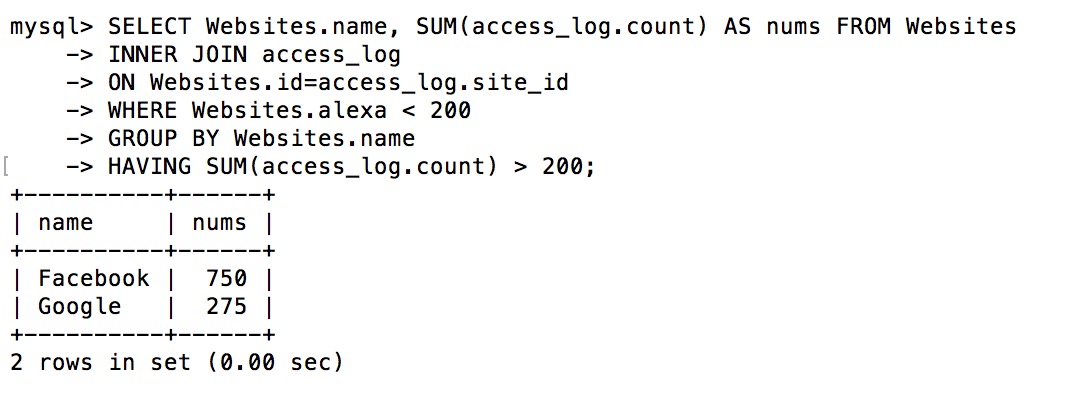SQL HAVING clause
HAVING clause
Increase in SQL HAVING clause because, WHERE keyword can not be used with aggregate functions.
HAVING clause allows us to filter after each set of data packets.
SQL HAVING Syntax
SELECT column_name, aggregate_function(column_name)
FROM table_name
WHERE column_name operator value
GROUP BY column_name
HAVING aggregate_function(column_name) operator value;
FROM table_name
WHERE column_name operator value
GROUP BY column_name
HAVING aggregate_function(column_name) operator value;
The demo database
In this tutorial, we will use w3big sample database.
The following is a selected "Websites" table data:
+----+--------------+---------------------------+-------+---------+ | id | name | url | alexa | country | +----+--------------+---------------------------+-------+---------+ | 1 | Google | https://www.google.cm/ | 1 | USA | | 2 | 淘宝 | https://www.taobao.com/ | 13 | CN | | 3 | 本教程 | http://www.w3big.com/ | 4689 | CN | | 4 | 微博 | http://weibo.com/ | 20 | CN | | 5 | Facebook | https://www.facebook.com/ | 3 | USA | | 7 | stackoverflow | http://stackoverflow.com/ | 0 | IND | +----+---------------+---------------------------+-------+---------+
Here is the data "access_log" website access record table:
mysql> SELECT * FROM access_log; +-----+---------+-------+------------+ | aid | site_id | count | date | +-----+---------+-------+------------+ | 1 | 1 | 45 | 2016-05-10 | | 2 | 3 | 100 | 2016-05-13 | | 3 | 1 | 230 | 2016-05-14 | | 4 | 2 | 10 | 2016-05-14 | | 5 | 5 | 205 | 2016-05-14 | | 6 | 4 | 13 | 2016-05-15 | | 7 | 3 | 220 | 2016-05-15 | | 8 | 5 | 545 | 2016-05-16 | | 9 | 3 | 201 | 2016-05-17 | +-----+---------+-------+------------+ 9 rows in set (0.00 sec)
Examples of SQL HAVING
Now we want to find the total number of visits is greater than 200 sites.
We use the following SQL statement:
Examples
SELECT Websites.name, Websites.url, SUM(access_log.count) AS nums FROM
(access_log
INNER JOIN Websites
ON access_log.site_id=Websites.id)
GROUP BY Websites.name
HAVING SUM(access_log.count) > 200;
INNER JOIN Websites
ON access_log.site_id=Websites.id)
GROUP BY Websites.name
HAVING SUM(access_log.count) > 200;
Execute the above SQL output results are as follows:

Now we want to find the total number of visits is greater than 200 sites, and less than 200 alexa rank.
We add an ordinary SQL statement WHERE clause:
Examples
SELECT Websites.name, SUM(access_log.count) AS nums FROM
Websites
INNER JOIN access_log
ON Websites.id=access_log.site_id
WHERE Websites.alexa < 200
GROUP BY Websites.name
HAVING SUM(access_log.count) > 200;
INNER JOIN access_log
ON Websites.id=access_log.site_id
WHERE Websites.alexa < 200
GROUP BY Websites.name
HAVING SUM(access_log.count) > 200;
Execute the above SQL output results are as follows:
